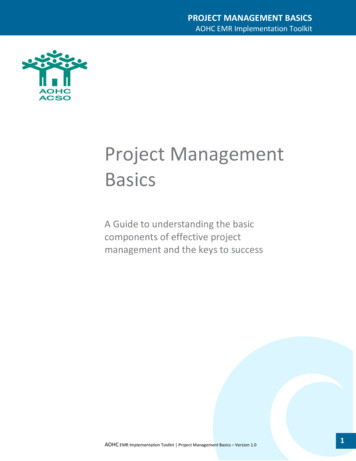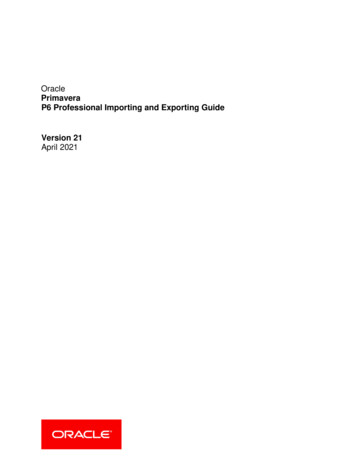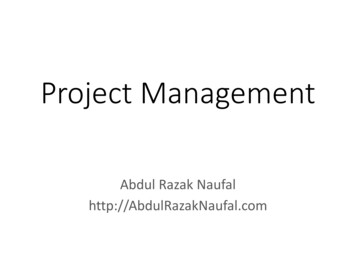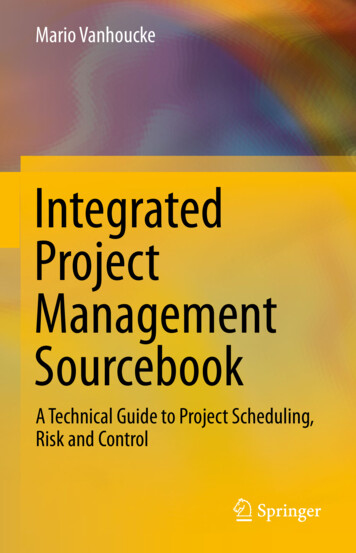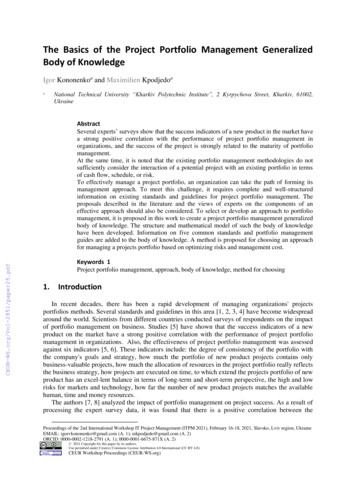
Transcription
The Basics of the Project Portfolio Management GeneralizedBody of KnowledgeIgor Kononenkoa and Maximilien KpodjedoaaNational Technical University “Kharkiv Polytechnic Institute”, 2 Kyrpychova Street, Kharkiv, 61002,UkraineAbstractSeveral experts’ surveys show that the success indicators of a new product in the market havea strong positive correlation with the performance of project portfolio management inorganizations, and the success of the project is strongly related to the maturity of portfoliomanagement.At the same time, it is noted that the existing portfolio management methodologies do notsufficiently consider the interaction of a potential project with an existing portfolio in termsof cash flow, schedule, or risk.To effectively manage a project portfolio, an organization can take the path of forming itsmanagement approach. To meet this challenge, it requires complete and well-structuredinformation on existing standards and guidelines for project portfolio management. Theproposals described in the literature and the views of experts on the components of aneffective approach should also be considered. To select or develop an approach to portfoliomanagement, it is proposed in this work to create a project portfolio management generalizedbody of knowledge. The structure and mathematical model of such the body of knowledgehave been developed. Information on five common standards and portfolio managementguides are added to the body of knowledge. A method is proposed for choosing an approachfor managing a projects portfolio based on optimizing risks and management cost.Keywords 1Project portfolio management, approach, body of knowledge, method for choosing1.IntroductionIn recent decades, there has been a rapid development of managing organizations' projectsportfolios methods. Several standards and guidelines in this area [1, 2, 3, 4] have become widespreadaround the world. Scientists from different countries conducted surveys of respondents on the impactof portfolio management on business. Studies [5] have shown that the success indicators of a newproduct on the market have a strong positive correlation with the performance of project portfoliomanagement in organizations. Also, the effectiveness of project portfolio management was assessedagainst six indicators [5, 6]. These indicators include: the degree of consistency of the portfolio withthe company's goals and strategy, how much the portfolio of new product projects contains onlybusiness-valuable projects, how much the allocation of resources in the project portfolio really reflectsthe business strategy, how projects are executed on time, to which extend the projects portfolio of newproduct has an excel-lent balance in terms of long-term and short-term perspective, the high and lowrisks for markets and technology, how far the number of new product projects matches the availablehuman, time and money resources.The authors [7, 8] analyzed the impact of portfolio management on project success. As a result ofprocessing the expert survey data, it was found that there is a positive correlation between theProceedings of the 2nd International Workshop IT Project Management (ITPM 2021), February 16-18, 2021, Slavsko, Lviv region, UkraineEMAIL: igorvkononenko@gmail.com (A. 1); mkpodjedo@gmail.com (A. 2)ORCID: 0000-0002-1218-2791 (A. 1); 0000-0001-6675-871X (A. 2) ️ 2021 Copyright for this paper by its authors.Use permitted under Creative Commons License Attribution 4.0 International (CC BY 4.0).CEUR Workshop Proceedings (CEUR-WS.org)
application of project portfolio management and project success. A strong positive correlationcoefficient was noted between the level of maturity of project portfolio management and projectsuccess.It was shown in [9] that managing a portfolio of projects had a significant impact on the marketshare of business organizations in Nigeria. In addition, effective portfolio management has had apositive impact on the capital growth of these business organizations.In [10], it was noted that existing portfolio management methodologies focus on the consistency ofthe portfolio with the organization’s strategic objectives and financial results. At the same time,insufficient attention is paid to the impact of the project, which is added to the portfolio, on portfoliorisks, capital costs, cash flows, time-tables, resource allocation. It is proposed [10] to create newmethodologies for man-aging project portfolios that will bridge the gap between the strategic focus ofthe portfolio and the operational activities of managers to agree on the mutual influence of projects onrisks, capital costs, cash flows, schedules, and resource allocation.Project portfolio management is one of the most important management functions in today'senterprise. The success of achieving the strategic goals of the enterprise depends on the approachtaken to manage the portfolio of projects. By the approach to managing a portfolio of projects weunderstand the methodology of managing a portfolio of projects, supplemented by methods and toolsfor performing processes, document templates. By the project portfolio management methodology, wemean a defined and documented system of principles, rules, processes, practices, life cycle,organizational structure, and prescribed roles that provide project portfolio management in theorganization [11]. The concept of portfolio management methodology is highlighted to refer to thefundamental components of the approach. These components are often determined by the chosenstandard or portfolio management guide [1, 2, 3, 4]. These components in an organization aresupplemented by methods of implementation of certain processes, portfolio management tools,document templates.When implementing project portfolio management, each organization is faced with the problem ofchoosing an existing approach from known approaches or forming its own approach, withconsideration to its specificities and environment. For both the first and second tasks, structuredinformation about existing standards and guidelines in this area are needed. The suggestions fromliterature and experts’ opinions on the components of an effective approach should also beconsidered. To this end, it is advisable to create a generalized body of knowledge on portfoliomanagement.Thus, the purpose of the article is to create the basics of the project portfolio managementgeneralized body of knowledge. In this article, we will focus on traditional approaches to portfoliomanagement. Because, according to the survey results [12], 56% of organizations use traditionalapproaches to project management, 22% of organizations use Agile approaches, and 19% oforganizations use hybrid approaches. In IT, 33% of organizations use Agile approaches, and 22% oforganizations use hybrid approaches. 3060 project professionals from all over the world have takenpart in the survey. Among the analyzed organizations, 17% were IT companies. Due to thewidespread prevalence of traditional approaches in project management, including the IT industry, wewill begin to create the generalized body of knowledge on portfolio management, starting withtraditional approaches.2.The Structure of a Generalized Body of Knowledge on Project PortfolioManagementThe structure of the generalized body of knowledge on project portfolio management is proposed.It includes principles, processes, practices, life cycles, organizational structures, defined roles,from common standards, portfolio management guides, publications in this area, considering theopinions of experts [1-4, 13].The difficulty of creating the generalized body of knowledge is that well-known standards andguidelines differ significantly in the principles and structure of the presentation of materials, in theprinciples, processes, and practices of managing a portfolio of projects, in the proposed life cycles of
management, organizational structures, and prescribed roles. Most of these standards don’t describethe portfolio management processes.The structure of the developed generalized body of knowledge is shown in Fig.1.Principles [1] (8main principles)Principles [2](5 principles)Processes [13](16 processes)Roles [4](3 roles)Roles [2](5 roles)Proposals [3](7 proposals)PrinciplesRolesProcessesRoles[1] (12roles)Generalized bodyofknowledgeOrganizationalStructure [2]OrganizationalstructuresProcesses [4](9 processes)Processes ofthe authors(23 processes)PracticesLifeCyclesPractices [2](12practices)Organizationalstructure, used n[1]Definitioncycle, Deliverycycle [2]Figure 1: Structure of the project portfolio management generalized body of knowledgeThe structure of the project portfolio management generalized body of knowledge can be specifiedin the form of a set G P, Z , Q, L, O, R , where P - is the set of principles of portfolio management, in this case P P[ 2] , P[3] , P[ 2] - 8 principles of the standard [1], P[3] - 5 principles of the guide [2], Z - is the set of the project portfolio management processes, Z Z [1] , Z [ 4] , Z [5] , Z [ a ] ,[1][ 4][ 5]Z - 16 processes of the standard [13], Z - 7 proposals of the standard [3], Z - 9 processes ofthe standard [4], Z [a ] - 23 processes, proposed by the authors, Q - is the set of practices, in this case, these are 12 practices described in the guide [2], L - is the set of life cycles, L L[ 2] , L[3] , L[ 2] - lifecycle in accordance with the standard [1], consisting of the phases of initiation, planning, execution,
optimization, L[3] - the life cycle in accordance with the guide [2], including the definition cycle andthe delivery cycle, O - is the set of types of organizational structures, O O[3] , O[ p ] , O[3] - the [ p]organizational structure proposed in the guide [2], O - the organizational structure used in practice,R - is the set of roles, R R[ 2] , R[3] , R[5] , R[ 2] - 12 roles described in the standard [1], R[3] - 5 roles [ 5]proposed in the guide [2], R - 3 roles provided by the standard [4].It should be noted that the standard [13] can be represented in the body of knowledge by theset G [1] Z [1] , the standard [1] – by the set G[ 2] P[ 2] , L[ 2] , R[ 2] , the guide [2] – by the set Z , the standard [4] – by the[ 4]G[3] P[3] , Q[3] , L[3] , O[3] , R[3] , the standard [3] – by the set G[ 4]set G[5] Z [5] , R[5] . This view allows us to conclude how fully the listed standards and guidelines cover the project portfolio management methodology.3. Principles of Portfolio ManagementLet’s consider the principles of portfolio management proposed in [1, 2].The standard [1] contains the following main principles of portfolio management: Strive to achieve excellence in strategic performance; Enhance transparency, responsibility, accountability, sustainability, and fairness; Balance portfolio value with overall risks; Ensure that investments in portfolio components are aligned with the organization’sstrategy; Obtain and maintain the sponsorship and engagement of senior management and keystakeholders; Exercise active and decisive leadership in optimizing resource utilization; Foster a culture that embraces change and risk; and Manage complexity to enable successful outcomes.The guide [2] proposes five principles for portfolio management.Portfolio Management Principle 1: Senior management commitment.This principle assumes that senior management should create a decision-making structure inaccordance with the organization’s strategy, provide a mechanism for determining priorities for theportfolio in accordance with business goals, and demonstrate commitment to change.Portfolio Management Principle 2: Governance alignment.The principle of governance alignment is that roles should be clearly defined in relation toportfolio management, portfolio management should be consistent with thebroader organizational structure of management, and the process of escalation of problems shouldbe agreed upon. Meeting schedules of governing bodies should also be agreed.Portfolio Management Principle 3: Strategy alignment.This principle means that the allocation of funds through various types of initiatives and individualinitiatives reflects the relative importance of the organization's strategic objectives and the expectedcontribution of the initiatives to these objectives.Portfolio Management Principle 4: Portfolio Office.This principle defines the key services of the portfolio management office.Portfolio Management Principle 5: An energized change culture.This principle implies: senior management commitment, communication and motivation; mutual and common desire to succeed based on the effective involvement of employees; effective management with an appropriate level of bureaucracy; culture and behavior reflect an orientation towards the common good and success of theorganization, and not towards the interests of individuals.A comparison of these principles (Table 1) shows that the standard [1] pays more attention to thecriteria and ways to achieve the goal, while the guide [2] emphasizes the importance of portfoliomanagement office services.
4. A Generalized Table of ProcessesA generalized table of processes for the portfolio management body of knowledge has beendeveloped.As a basis for creating this table of processes, the standard [13], which is process oriented wasused. Guidelines and standards [1, 2, 3] are not process-oriented.The following process groups are proposed for the generalized process table: “determination ofgoals and criteria, management principles, methods for achieving goals, resources, appointment of aportfolio manager”, “preliminary selection of components”, “balancing (optimization) of a portfolio”,“authorization of components”, “monitoring and control (accounting and forecasting, control,analysis, decision making)”, “closing of components”).This table proposes to leave the standard [13] areas of knowledge: Portfolio StrategicManagement, Portfolio Governance Management, Portfolio Performance Management, PortfolioCommunication Management, and Portfolio Risk Management.Table 1The comparison of principlesAreasOrganization of work ofportfolio managersEngagement of keystakeholdersAlignment with the strategyOffice organizationCommitment to changeCriteriaWays to achieve goalsThe principles of portfoliomanagement proposed in [1]Enhance transparency,responsibility, accountability,sustainability, and fairnessExercise active and decisiveleadership in optimizingresource utilizationObtain and maintain thesponsorship and engagementof senior management and keystakeholdersStrive to achieve excellence instrategic performanceEnsure that investments inportfolio components arealigned with the organization’sstrategyFoster a culture that embraceschange and riskBalance portfolio value withoverall risksManage complexity to enablesuccessful outcomesThe principles of portfoliomanagement proposed in [2]Senior managementcommitmentGovernance alignmentStrategy alignmentPortfolio OfficeAn energized change cultureThe processes of the standard [13] are presented in a generalized table. When applying theproposed table, the processes [13] “Develop Portfolio Charter”, “Manage Strategic Change”,“Manage Supply and Demand”, “Manage Portfolio Value”, “Manage Portfolio Information”,“Manage Portfolio Risks” were simultaneously found in several cells , which indicates a certainambiguity of these processes presented in this view.As already noted, the ISO 21504: 2015 standard [3] is not process-oriented. It suggests what shouldbe done when managing a portfolio without a description of the inputs and outputs. There is nodivision of these proposals into groups of processes and areas of knowledge. The proposals of thestandard [3] were also presented in the form of processes in a generalized table.
As a result, it turned out that such proposals as “Assessing and selecting portfolio components”,“Validating portfolio alignment to strategic objectives”, “Balancing and optimizing the portfolio”appeared simultaneously in several areas of knowledge or process groups, which indicates a certainambiguity of these proposals. In the description of these sentences, actions cover more than one areaof knowledge or a group of processes.The standard [4] contains a description of 9 portfolio management processes, divided into 3 groupsof processes:a) a portfolio management process group, including the process of collecting information about the conditions, limitations and requirements forthe project portfolio; the process of formalizing management procedures and project portfolio assessmentparameters;b) a group of processes for forming a portfolio of projects, including the process of identifying portfolio components; the process of evaluating portfolio components; the process of prioritization; the process of optimizing and balancing a portfolio of projects; the process of authorizing a portfolio of projects;c) a group of processes for monitoring and controlling the portfolio of projects, including the process of monitoring the implementation of the portfolio of projects; change management process.These processes are presented in a generalized table.Along with the sets of processes described in the above documents [3, 4, 13,], a set of portfoliomanagement processes is proposed, which, in our opinion, meets the requirements of manyorganizations. This set includes both well-known processes and those proposed by us (Table 2, Table3).5. Practices in Portfolio ManagementOne of the documents under consideration, namely the guide [2], contains a description ofportfolio management practices that correspond to the phases of the portfolio life cycle.The definition cycle provides for 5 practices: Understand, Categorize, Prioritize, Balance, and Plan.The delivery cycle defines 7 practices: Management control, Benefits management, Financialmanagement, Risk management, Stakeholder engagement, Organizational management, and Resourcemanagement.6.Portfolio Management LifecyclesTwo of the five documents under consideration offer portfolio life cycles.The standard [1] proposes a portfolio life cycle, which consists of 4 stages: Initiation, Planning,Execution and Optimization. Instead of processes, it describes what needs to be done, whatdocuments to prepare.The portfolio life cycle, according to the guide [2], consists of the definition cycle and the deliverycycle of the portfolio.7.Organizational Structures of Portfolio ManagementThe guide [2] proposes a variant of the organizational structure of portfolio management. Thecomponents of the organizational structure [2] are not presented in the form of a graph, which wouldfacilitate understanding of the relationships and subordination of participants. This variant is indicatedoptional. The organizational structure includes: Portfolio direction group / Investment committee,Director of change, Chief executive, Commercial director, Directors, Portfolio progress group /
Change management committee, Director of change, Portfolio and portfolio office management,Senior resource management, Senior program and project management, Senior business as usualmanagement, Program and project management forum, Program and project management, Portfoliooffice, Portfolio hub / Program and project office.Table 2The proposed processesProcess ManagementPortfolioRiskManagement8.Determination ofGoals and Criteria,ManagementPrinciples,Methods forAchieving Goals,Resources, andAppointment of aPortfolio Manager1. Developmentand approval ofthe charter of theportfolio2. Developmentof a portfoliomanagementplan11.Developmentof a portfolioperformancemanagementplan14. Developmentof a plan forinteraction withstakeholders21. Developing arisk managementplanPreliminarySelection ofComponents3.Preliminaryselection,evaluation andcategorization ofpotentialcomponentsBalancing(Optimization)of a s andthewholeportfolioAuthorization ofComponents5.Componentauthorization.12. Evaluation ofthe effectivenessof potentialcomponents15. Exchange ofinformation withstakeholders in theprocess of thepreliminaryselection ofcomponents22. Riskassessment ofpotentialcomponents16. Exchange ofinformationwithstakeholders inthe process ofportfoliooptimizationRoles in Portfolio ManagementWhen managing a portfolio in accordance with the standard [1], the following roles areconsidered:Portfolio manager, Sponsors, Portfolio governance body, Portfolio, program, and projectmanagement office (PMO), Portfolio analyst, Program managers, Project managers, Change control
board, Program and project team members, Subject matter experts, Business analysts, and Functionalmanagers in charge of portfolio operations.The guide [2] defines the following roles in managing a portfolio of projects: portfolio directiongroup or investment committee; portfolio progress group or change delivery committee; businesschange director or portfolio director; portfolio manager; portfolio benefits manager.The standard [4] considers the following roles in managing any project portfolio: project portfoliomanagement committee, portfolio manager, project portfolio management office.Table 3The proposed processes ationManagementPortfolioRiskManagementProcess GroupsMonitoring and ControlControlAnalysisAccounting andDecisionforecastingmaking6. Portfolio7. Portfolio8. Analysis of9. ting andperformanceforecasting13. Monitoring and managing portfolio performance17. Exchange ofinformationwithstakeholders onthe results ofaccounting andforecastingportfolioperformanceClosing ofComponents10.Componentclosure18. Exchange ofinformationwithstakeholders onthe results ofmonitoringportfolioperformance.19. Exchange 20. ders stakeholderson theon theresults ofdecisionsportfoliotakenperformanceanalysis23. Portfolio risk monitoring and management9. Choosing an approach for portfolio managementImplementing portfolio management for an organization involves choosing a portfoliomanagement approach from existing approaches or creating your own option. The project portfoliomanagement generalized body of knowledge proposed in this paper can help an organization create itsown approach, as it contains structured information about the most requested standards andguidelines. In the future, it is planned to replenish the body of knowledge with information aboutother existing approaches, including Agile ones. However, the problem of choosing the best possibleapproach remains unresolved. Traditionally, it is solved heuristically by the leading specialists of theorganization based on their experience and intuition. For a more objective and formalized solution tothis problem, the choice can be made by using two criteria: the quality of project portfoliomanagement and the cost of project portfolio management. Let's consider these criteria in more detail.One of the indicators that can characterize the quality of an approach to project portfoliomanagement are the risks inherent in this approach when managing an organization's project portfolioin specific conditions. The lower these risks are, the more qualitative is the approach applied.
To assess the potential risks of the j -th approach to project portfolio management, j 1, J , J -thenumber of approaches under consideration, it is proposed to use the generalized table of projectportfolio management processes (Table 2 and Table 3) [13].Each cell of the generalized process table corresponds to a specific knowledge area and a group ofproject portfolio management processes. It may or may not contain a management process. Each suchcell is assessed in terms of the consequences of the risks arising from the failure to carry out theprocess that may be in this cell. The consequences of potential risks s jk , k 1, K , it is proposed toevaluate on a five-point scale, K is the number of processes in a generalized table, K 36 . Themaximum score "5" corresponds to the maximum negative consequence of the risk. The followinggrading system can be adopted:5 points - disastrous consequences for the organization,4 points - the loss of very significant benefits for the organization, which will make it difficult toachieve its strategic goals,3 points - loss of noticeable benefits for the organization,2 points - loss of benefits that will not affect the achievement of the organization's strategic goals,1 point - insignificant loss of benefits for the organization.Tables 4 and 5 show the authors' estimates of potential risks.Table 4Consequences of risks arising from non-execution of the processKnowledge AreasProcess GroupsDetermination ofPreliminaryBalancingGoals and Criteria,Selection of(Optimization) ofManagementComponentsa PortfolioPrinciples,Methods forAchieving Goals,Resources, andAppointment of aPortfolio ementPortfolio44RiskManagementAuthorization ofComponents3---In addition, based on the knowledge of the organization, its strategy, the characteristics of theenvironment, the probabilities of these risks are evaluated p jk , k 1, K .The negative risk associated with non-fulfillment of the management process provided for in thegeneralized table is estimated by the value of the product of the probability and the consequences ofthe risk event.For the considered approach to project portfolio management, a generalized process table is filledin. For cells of the table that do not contain management processes, the product of the probability of
the occurrence of a risk event by the consequence of such an event is determined. The resulting worksare added.If the cell of the table contains the management process, s jk , k 1, K then, is taken equal to zero.If some cell of the generalized table contains a management process, but experts believe thatbecause of the imperfection of this process, anyway, the probability of occurrence of negativeconsequences remains, then the corresponding value can be assigned a non-zero value. In this case,the probability of such a risk event is also assessed.As a result, we obtain a risk assessment when using the considered approach to project portfoliomanagement. This assessment does not consider the relationship between the individual risk events.Therefore, it can be supplemented by an expert assessment of the synergistic effect from the entire setof risks characteristic of the approach under consideration. This estimate should also be obtained asthe product of the probability of a synergistic effect by its consequences. As a result, the riskassessment when using the j -th approach will beK 1R j p jk s jk .k 1Table 5Consequences of risks arising from non-execution of the process. (continued)KnowledgeProcess GroupsAreasMonitoring and ControlAccounting tfolio4444RiskManagementClosing ofComponents3---The second component for evaluating a portfolio management approach is the cost C j of itsapplication. At the same time, it is necessary to consider the costs of purchasing tools for itsimplementation, which include computer equipment, communications, and software. Considerationshould be given to the cost of training personnel, the ongoing costs associated with the operation ofthe selected tools. An important component of the costs is the payment for the work of the personnelinvolved in the implementation of the processes of the chosen approach to project portfoliomanagement.After the risk and cost estimates for alternative approaches to project portfolio management areobtained, the two-criteria optimization problem of choosing the most appropriate approach is solvedj arg min R j , C j j 1 .JjThis task can take into account the restrictions on the allowable costs C per , for the time of masteringthe approach in the organization Tper :
C j C per ,T j Tper .In the problem of optimizing the choice of approach, other restrictions can be considered.10. ConclusionWhen implementing project portfolio management, organizations choose one of the existingapproaches or create their own approach, which considers the peculiarities of the internal and externalenvironment, the specifics of the projects and programs being executed. Solving these tasks requires acomplete and well-structured information about existing standards and guidelines in the field ofproject portfolio management. Consideration should also be given to suggestions in the literature andexpert opinions on the components of an effective approach. To select or form an approach tomanaging a portfolio of projects in the work, it is proposed to create a generalized body of knowledgeon managing a portfolio of projects. The structure of such a body of knowledge has been developed. Itincludes sets of principles, processes, practices, life cycles, organizational structures, and roles inportfolio management.The body of knowledge is filled with information on five common standards and guidelines formanaging a portfolio of projects.Principles [1] and [2], grouped into 7 areas, which made it possible to compare them.A method for choosing an approach for managing a portfolio of projects is proposed. The methodis based on assessing the risks inherent in this approach when managing an organization's projectportfolio in specific conditions, and the cost of portfolio management. The method involves solving atwo-criterion optimization problem, considering the constraints on the permissible costs and time ofmastering the approach in the organization.Subsequent papers will use this method to selec
Portfolio Management Principle 2: Governance alignment. The principle of governance alignment is that roles should be clearly defined in relation to portfolio management, portfolio management should be consistent with the broader organizational structure of management, and the process of escalation of problems should be agreed upon.



